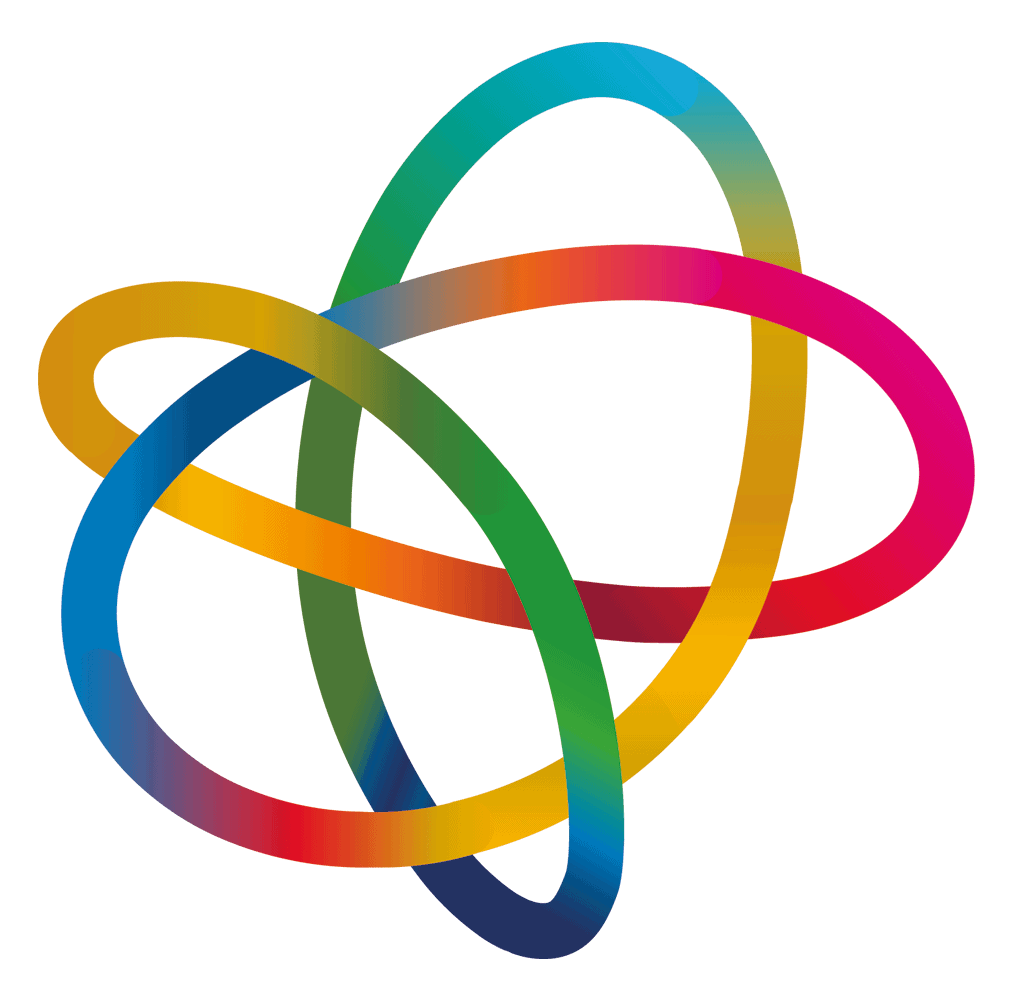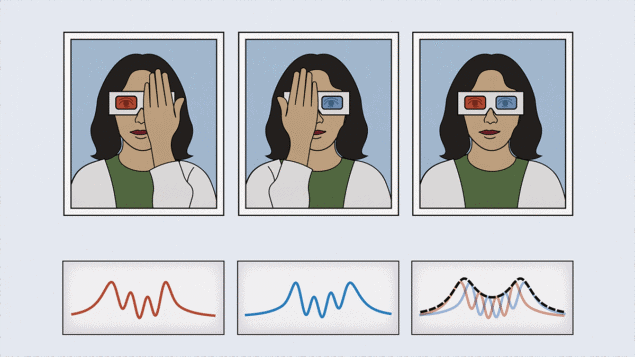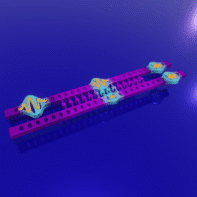
Part of our International Year of Quantum Science and Technology coverage
In the third of our series of truly weird quantum effects, Maria Violaris investigates the paradoxical delayed-choice quantum eraser

“Welcome to this special issue of Physics World, marking the 200th anniversary of quantum mechanics. In this double-quantum edition, the letters in this text are stored using qubits. As you read, you project the letters into a fixed state, and that information gets copied into your mind as the article that you are reading. This text is actually in a superposition of many different articles, but only one of them gets copied into your memory. We hope you enjoy the one that you are reading.”
That’s how I imagine the opening of the 2125 Physics World quantum special issue, when fully functional quantum computers are commonplace, and we have even figured out how to control individual qubits on display screens. If you are lucky enough to experience reading such a magazine, you might be disappointed as you can read only one of the articles the text gets projected into. The problem is that by reading the superposition of articles, you made them decohere, because you copied the information about each letter into your memory. Can you figure out a way to read the others too? After all, more Physics World articles is always better.
A possible solution may be if you could restore the coherence of the text by just erasing your memory of the particular article you read. Once you no longer have information identifying which article your magazine was projected into, there is then no fundamental reason for it to remain decohered into a single state. You could then reread it to enjoy a different article.
While this thought experiment may sound fantastical, the concept is closely connected to a mind-bending twist on the famous double-slit experiment, known as the delayed-choice quantum eraser. It is often claimed to exhibit a radical phenomenon: where measurements made in the present alter events that occurred in the past. But is such a paradoxical suggestion real, even in the notoriously strange quantum realm?
A double twist on the double slit
In a standard double-slit experiment, photons are sent one by one through two slits to create an interference pattern on a screen, illustrating the wave-like behaviour of light. But if we add a detector that can spot which of the two slits the photon goes through, the interference disappears and we see only two distinct clumps on the screen, signifying particle-like behaviour. Crucially, gaining information about which path the photon took changes the photon’s quantum state, from the wave-like interference pattern to the particle-like clumps.
The first twist on this thought experiment is attributed to proposals from physicist John Wheeler in 1978, and a later collaboration with Wojciech Zurek in 1983. Wheeler’s idea was to delay the measurement of which slit the photon goes through. Instead of measuring the photon as it passes through the double-slit, the measurement could be delayed until just before the photon hits the screen. Interestingly, the delayed detection of which slit the photon goes through still determines whether or not it displays the wave-like or particle-like behaviour. In other words, even a detection done long after the photon has gone through the slit determines whether or not that photon is measured to have interfered with itself.
If that’s not strange enough, the delayed-choice quantum eraser is a further modification of this idea. First proposed by American physicists Marlan Scully and Kai Drühl in 1982 (Phys. Rev. A 25 2208), it was later experimentally implemented by Yoon-Ho Kim and collaborators using photons in 2000 (Phys. Rev. Lett. 84 1). This variation adds a second twist: if recording which slit the photon passes through causes it to decohere, then what happens if we were to erase that information? Imagine shrinking the detector to a single qubit that becomes entangled with the photon: “left” slit might correlate to the qubit being 0, “right” slit to 1. Instead of measuring whether the qubit is a 0 or 1 (revealing the path), we could measure it in a complementary way, randomising the 0s and 1s (erasing the path information).
1 Delayed detections, path revelations and complementary measurements
This illustration depicts how the quantum eraser restores the wave-like behaviour of photons in a double-slit experiment, using 3D-glasses as an analogy.
The top left box shows the set-up for the standard double-slit experiment. As there are no detectors at the slits measuring which pathway a photon takes, an interference pattern emerges on the screen. In box 1, detectors are present at each slit, and measuring which slit the photon might have passed through, the interference patter is destroyed. Boxes 2 and 3 show that by erasing the “which-slit” information, the interference patterns are restored. This is done by separating out the photons using the eraser, represented here by a red filter and a blue filter of the 3D glasses. The final box 4 shows that the overall pattern with the eraser has no interference, identical to patten seen in box 1.
In boxes 2, 3 and 4, a detector qubit measures “which-slit” information, with states |0> for left and |1> for right. These are points on the z-axis of the “Bloch sphere”, an abstract representation of the qubit. Then the eraser measures the detector qubit in a complementary way, along the x-axis of the Bloch sphere. This destroys the “which-slit information”, but reveals the red and blue lens information used to filter the outcomes, as depicted in the image of the 3D glasses.
Strikingly, while the screen still shows particle-like clumps overall, these complementary measurements of the single-qubit detector can actually be used to extract a wave-like interference pattern. This works through a sorting process: the two possible outcomes of the complementary measurements are used to separate out the photon detections on the screen. The separated patterns then each individually show bright and dark fringes.
I like to visualize this using a pair of 3D glasses, with one blue and one red lens. Each colour lens reveals a different individual image, like the two separate interference patterns. Without the 3D glasses, you see only the overall sum of the images. In the quantum eraser experiment, this sum of the images is a fully decohered pattern, with no trace of interference. Having access to the complementary measurements of the detector is like getting access to the 3D glasses: you now get an extra tool to filter out the two separate interference patterns.
Rewriting the past – or not?
If erasing the information at the detector lets us extract wave-like patterns, it may seem like we’ve restored wave-like behaviour to an already particle-like photon. That seems truly head-scratching. However, Jonte Hance, a quantum physicist at Newcastle University in the UK, highlights a different conclusion, focused on how the individual interference patterns add up to show the usual decohered pattern. “They all feel like they shouldn’t be able to fit together,” Hance explains. “It’s really showing that the correlations you get through entanglement have to be able to fit every possible way you could measure a system.” The results therefore reveal an intriguing aspect of quantum theory – the rich, counterintuitive structure of quantum correlations from entanglement – rather than past influences.
Even Wheeler himself did not believe the thought experiment implies backward-in-time influence, as explained by Lorenzo Catani, a researcher at the International Iberian Nanotechnology Laboratory (INL) in Portugal. Commenting on the history of the thought experiment, Catani notes that “Wheeler concluded that one must abandon a certain type of realism – namely, the idea that the past exists independently of its recording in the present. As far as I know, only a minority of researchers have interpreted the experiment as evidence for retrocausality.”
Eraser vs Bell: a battle of the bizarre
One physicist who is attempting to unpack this problem is Johannes Fankhauser at the University of Innsbruck, Austria. “I’d heard about the quantum eraser, and it had puzzled me a lot because of all these bizarre claims of backwards-in-time influence”, he explains. “I see something that sounds counterintuitive and puzzling and bizarre and then I want to understand it, and by understanding it, it gets a bit demystified.”

Curiouser and curiouser: delving into quantum Cheshire cats
Fankhauser realized that the quantum eraser set-up can be translated into a very standard Bell experiment. These experiments are based on entangling a pair of qubits, the idea being to rule out local “hidden-variable” models of quantum theory. This led him to see that there is no need to explain the eraser using backwards-in-time influence, since the related Bell experiments can be understood without it, as explained in his 2017 paper (Quanta 8 44). Fankhauser then further analysed the thought experiment using the de Broglie–Bohm interpretation of quantum theory, which gives a physical model for the quantum wavefunction (as particles are guided by a “pilot” wave). Using this, he showed explicitly that the outcomes of the eraser experiment can be fully explained without requiring backwards-in-time influences.
So does that mean that the eraser doesn’t tell us anything else beyond what Bell experiments already tell us? Not quite. “It turns different knobs than the Bell experiment,” explains Fankhauser. “I would say it asks the question ‘what do measurements signify?’, and ‘when can I talk about the system having a property?’. That’s an interesting question and I would say we don’t have a full answer to this.”
In particular, the eraser demonstrates the importance that the very act of observation has on outcomes, with the detector playing the role of an observer. “You measure some of its properties, you change another property,” says Fankhauser. “So the next time you measure it, the new property was created through the observation. And I’m trying to formalize this now more concretely. I’m trying to come up with a new approach and framework to study these questions.”
Meanwhile, Catani found an intriguing contrast between Bell experiments and the eraser in his research. “The implications of Bell’s theorem are far more profound,” says Catani. In the 2023 paper (Quantum 7 1119) he co-authored, Catani considers a model for classical physics, with an extra condition: there is a restriction on what you can know about the underlying physical states. Applying this model to the quantum eraser, he finds that its results can be reproduced by such a classical theory. By contrast, the classical model cannot reproduce the statistical violations of a Bell experiment. This shows that having incomplete knowledge of the physical state is not, by itself, enough to explain the strange results of the Bell experiment. It is therefore demonstrating a more powerful deviation from classical physics than the eraser. Catani also contrasts the mathematical rigour of the two cases. While Bell experiments are based on explicitly formulated assumptions, claims about backwards-in-time influence in the quantum eraser rely on a particular narrative – one that gives rise to the apparent paradox
The eraser as a brainteaser
Physicists therefore broadly agree that the mathematics of the quantum eraser thought experiment fits well within standard quantum theory. Even so, Hance argues that formal results alone are not the entire story: “This is something we need to pick apart, not just in terms of mathematical assumptions, but also in terms of building intuitions for us to be able to actually play around with what quantumness is.” Hance has been analysing the physical implications of different assumptions in the thought experiment, with some options discussed in his 2021 preprint (arXiv:2111.09347) with collaborators on the quantum eraser paradox.
It therefore provides a tool for understanding how quantum correlations match up in a way that is not described by classical physics. “It’s a great thinking aid – partly brainteaser, partly demonstration of the nature of this weirdness.”
Information, observers and quantum computers
Every quantum physicist takes something different from the quantum eraser, whether it is a spotlight on the open problems surrounding the properties of measured systems; a lesson from history in mathematical rigour; or a counterintuitive puzzle to make sense of. For a minority that deviate from standard approaches to quantum theory, it may even be some form of backwards-in-time influence.
For myself, as explained in my video on YouTube and my 2023 paper (IEEE International Conference on Quantum Computing and Engineering 10.1109/QCE57702.2023.20325) on quantum thought experiments, the most dramatic implication of the quantum eraser is explaining the role of observers in the double-slit experiment. The quantum eraser emphasizes that even a single entanglement between qubits will cause decoherence, whether or not it is measured afterwards – meaning that no mysterious macroscopic observer is required. This also explains why building a quantum computer is so challenging, as unwanted entanglement with even one particle can cause the whole computation to collapse into a random state.
The quantum eraser emphasizes that even a single entanglement between qubits will cause decoherence, whether or not it is measured afterwards – meaning that no mysterious macroscopic observer is required
Where does this leave the futuristic readers of our 200-year double-quantum special issue of Physics World? Simply erasing their memories is not enough to restore the quantum behaviour of the article. It is too late to change which article was selected. Though, following an eraser-type protocol, our futurists can do one better than those sneaky magazine writers: they can use the outcomes of complementary measurements on their memory, to sort the article into two individual smaller articles, each displaying their own quantum entanglement structure that was otherwise hidden. So even if you can’t use the quantum eraser to rewrite the past, perhaps it can rewrite what you read in the future.
This article forms part of Physics World‘s contribution to the 2025 International Year of Quantum Science and Technology (IYQ), which aims to raise global awareness of quantum physics and its applications.
Stayed tuned to Physics World and our international partners throughout the next 12 months for more coverage of the IYQ.
Find out more on our quantum channel.





